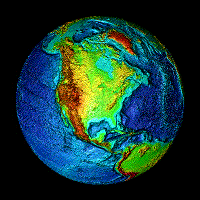

WEDD Implications for Petroleum and Natural Gas Origination
 
WEDD Implications for Petroleum and Natural Gas Origination |
 The
geology of planet Earth according to Whole-Earth Decompression Dynamics (WEDD)
[1-3]is primarily the consequence of two processes: (1) The
progressive formation of surface cracks to increase surface area in response to
decompression-increased planetary volume, and; (2) The
progressive adjustment of surface curvature in response to
decompression-increased planetary volume.
The
geology of planet Earth according to Whole-Earth Decompression Dynamics (WEDD)
[1-3]is primarily the consequence of two processes: (1) The
progressive formation of surface cracks to increase surface area in response to
decompression-increased planetary volume, and; (2) The
progressive adjustment of surface curvature in response to
decompression-increased planetary volume.
Crustal fragmentation, called rifting, provides all of the crucial components for petroleum-deposit formation: basin, reservoir, source, and seal. Rifting causes the formation of deep basins, as presently occurring in the Afar triangle of Northeastern Africa, figure at right [3]. Augmented by georeactor heat channeled upwards from deep within the Earth [4], uplift from sub-surface swelling can sequester sea-flooded lands to form halite evaporite deposits, lead to dome formation, and can make elevated land susceptible to erosion processes, thus providing sedimentary material for reservoir rock in-filling of basins. Moreover, crustal fragmentation potentially exposes deep basins to sources of abiotic mantle methane and, although still controversial, methane-derived hydrocarbons [5].
The figure at right from [3] illustrates the East African Rift System in red. Petroleum discoveries are marked with green crosses. The pink cross marks Lake Kivu which reportedly contains contains 50 million tons of dissolved methane for which there is no adequate microbial source.
Drawing upon an understanding he developed with respect to the East African Rift System and the underlying rifting and extensive petroleum and natural gas deposits associated with the Siberian Traps, Herndon has predicted the extensively rifted region beneath the Deccan Traps of India will become the site of important energy-resource discoveries [3]. In fact, the first discovery has already been reported.
Return to Home Page NuclearPlanet.com
| References | |
| 1. | Herndon, J. M., Whole-Earth decompression dynamics. Current Science, 2005. 89(10), 1937-1941. (click here for pdf) |
| 2. | Herndon, J. M., Origin of mountains and primary initiation of submarine canyons: the consequences of Earth's early formation as a Jupiter-like gas giant. Current Science, 2012, 102, 1370-1372. (click here for pdf) |
| 3. | Herndon, J. M., Impact of recent discoveries on petroleum and natural gas exploration: Emphasis on India. Current Science, 2010, 98, 772-779. (click here for pdf) |
| 4. | Herndon, J. M., Geodynamic basis of heat transport in the Earth. Current Science, 2011. 101, 1440-1450. (click here for pdf) |
| 5. | Herndon, J. M., Enhanced prognosis for abiotic natural gas and petroleum resources. Current Science, 2006. 91, 596-598. (click here for pdf) |